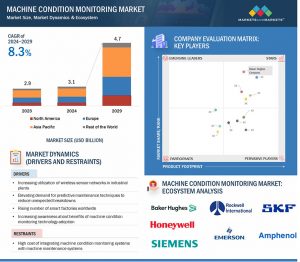The Machine Condition Monitoring Market is experiencing significant growth, driven by the increasing adoption of predictive maintenance strategies and advancements in sensor technology. The global machine condition monitoring market size is expected to grow from USD 3.1 billion in 2024 to USD 4.7 billion by 2029, at a CAGR of 8.3% from 2024 to 2029.
Market Segmentation
By Monitoring Technique
- Vibration Monitoring: Vibration monitoring is the most widely adopted technique for detecting faults and abnormalities in machinery. It is an effective method for identifying issues such as misalignments, unbalance, bearing wear, and mechanical looseness before they lead to more significant failures or downtime.
- Thermography: Thermography uses infrared cameras to detect and measure heat patterns in machinery. It is useful for identifying hot spots, insulation problems, and potential electrical issues.
- Oil Analysis: Oil analysis involves testing lubricating oils to determine their condition and detect any contaminants or wear particles. This technique helps optimize oil change intervals and identify potential mechanical problems.
- Ultrasound Emission: Ultrasound emission monitoring uses high-frequency sound waves to detect leaks, electrical discharges, and bearing wear. It is particularly useful in noisy environments where other monitoring techniques may be less effective.

Download PDF Brochure @ https://www.marketsandmarkets.com/pdfdownloadNew.asp?id=29627363
By Offering
- Hardware: Hardware offerings include vibration sensors, infrared sensors, spectrometers, corrosion probes, and spectrum analyzers. These components are essential for collecting data from machinery and transmitting it to monitoring systems.
- Software: Software solutions for machine condition monitoring provide data analysis, visualization, and reporting capabilities. They help maintenance teams interpret sensor data and make informed decisions about equipment maintenance.
Market Dynamics
Drivers
- Increasing demand for predictive maintenance: Organizations are shifting from reactive maintenance to proactive strategies that prevent equipment failures before they occur. Machine condition monitoring enables early detection of issues, reducing unplanned downtime and maintenance costs.
- Growing complexity of industrial machinery: As machinery becomes more complex and interconnected, the need for continuous monitoring and real-time data analysis has increased. Machine condition monitoring helps manage this complexity and ensures optimal equipment performance.
- Advancements in sensor technology: Innovations in sensor technology have led to more accurate and cost-effective sensors for measuring various parameters, such as vibration, temperature, pressure, and oil quality. These advancements have made machine condition monitoring more accessible and affordable.
Restraints
- High initial costs: Implementing a comprehensive machine condition monitoring system, including sensors, software, and infrastructure, can involve a substantial upfront investment. Small and medium-sized enterprises (SMEs) may find these costs prohibitive.
- Integration challenges: Integrating machine condition monitoring systems with existing equipment and infrastructure can be complex and time-consuming. Compatibility issues and the need for specialized expertise can hinder adoption.
Ask for Sample Report @ https://www.marketsandmarkets.com/requestsampleNew.asp?id=29627363
Key Players
- Emerson Electric Co. (US)
- Honeywell International Inc. (US)
- SKF (Sweden)
- Amphenol Corporation (US)
- Rockwell Automation, Inc. (US)
- Meggitt PLC (UK)
- GE Bently Nevada (US)
These companies offer a range of hardware and software solutions for machine condition monitoring, catering to various industries such as oil and gas, power generation, metals and mining, and aerospace and defense.
